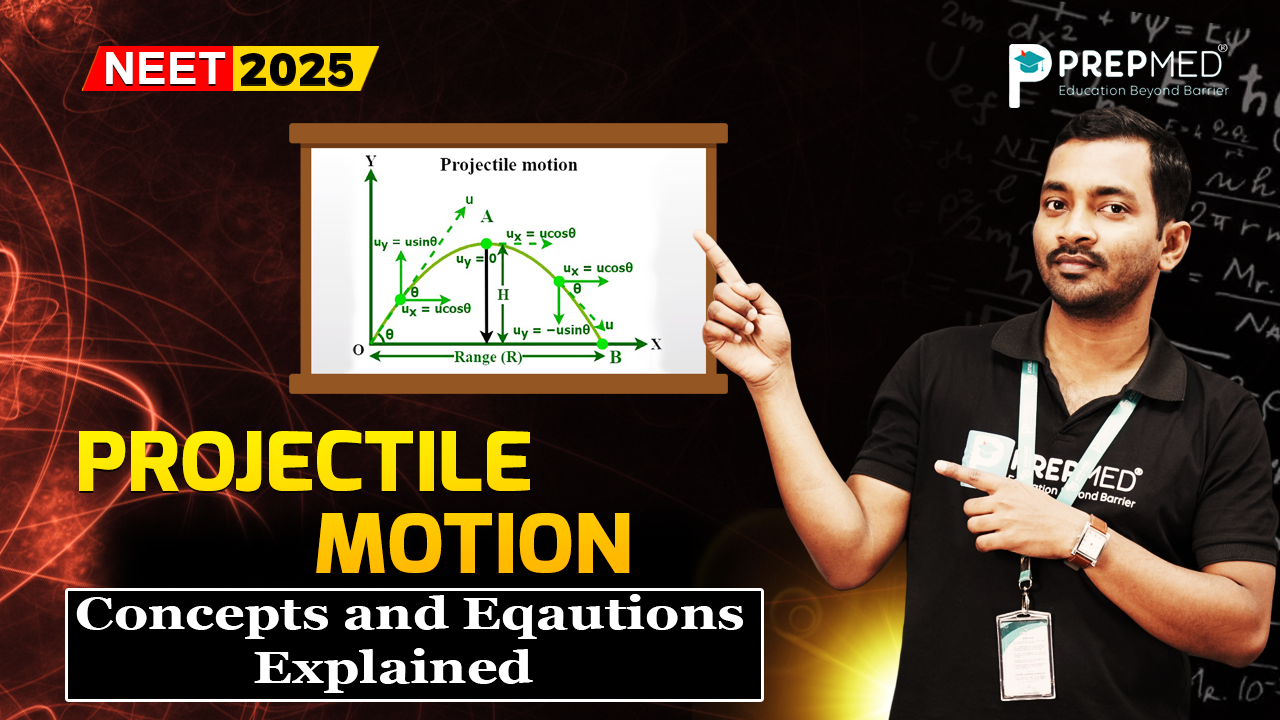March 29, 2025
Projectile Motion: Concepts and Equations Explained
Definition of projectile motion: A particle that moves through the air at an angle relative to horizontal follows a unique path in the air under the influence of gravitational force and is known as projectile motion. One needs to study velocity through two-dimensional components, which are separated into horizontal and vertical vectors, to analyze projectile motion. The basic knowledge of projectile trajectories as parabolas enables one to learn various physics applications in engineering fields and sports activities.
Key Concepts of Projectile Motion
- Initial Velocity:The velocity in which an object launches itself during projectile motion determines its initial speed. The motion velocity splits into two parts which are horizontal vx and vertical vy components. The angle at which the object is projected plays a crucial role in determining these components.
- Horizontal and Vertical Motion: In projectile motion, the horizontal and vertical motions are independent of each other:
- The horizontal velocity remains constant throughout the motion (ignoring air resistance).
- The vertical motion is influenced by gravitational acceleration, which causes the object to accelerate downward at a constant rate of approximately 9.8 m/s^2 on Earth.
- Acceleration Due to Gravity: The gravitational force draws the object in a downward direction, creating a continuous downward acceleration. The acceleration force on Earth is represented by g with a value of approximately 9.8 m/s^2. The object's vertical velocity at each instant depends significantly on this value.
- Time of Flight: The time the projectile spends in the air depends on its initial velocity and launch angle. The vertical motion equations help determine the time of flight by analyzing the projectile's ascent time until peak height and descent time toward the ground.
- Maximum Height: Maximum height is defined as the highest point of the projectile's flight. At this point, the vertical velocity of the projectile becomes zero before it starts descending. The maximum height depends on the vertical component of the initial velocity and gravity.
- Range of the Projectile: The range is the horizontal distance covered by the projectile before it hits the ground. The range depends on various factors such as: the initial velocity, launch angle, and the height from which the projectile is launched.
Equations of Projectile Motion
To understand and calculate projectile motion, we rely on several key equations. These equations of the projectile motion describe the horizontal and vertical motion of the object.
1. Horizontal Motion:
The horizontal motion of the projectile is described by the following equation:
x=vx⋅t
Where:
- x is the horizontal distance travelled by the projectile.
- vx is the horizontal component of the initial velocity (v0cos(θ)).
- t is the time of flight.
Since there is no horizontal acceleration (assuming air resistance is negligible), the horizontal velocity remains constant.
2. Vertical Motion:
The vertical motion can be described by the following equation:
y=vy⋅t−1/2gt2
Where:
- y is the vertical position of the projectile at any given time.
- vy is the vertical component of the initial velocity (v0sin(θ)).
- g is the acceleration due to gravity.
- t is the time.
This equation shows that the vertical motion is influenced by both the initial vertical velocity and gravity.
3. Time of Flight:
The time of flight, or the total time the projectile spends in the air, is given by:
t=2v0sin(θ)/g
Where:
- v0 is the initial velocity.
- Θ is the launch angle.
- g is the acceleration due to gravity.
4. Maximum Height:
The maximum height of the projectile can be calculated using the following formula:
H=v02 sin2(θ)/2g
Where:
- H is the maximum height.
- V0 is the initial velocity.
- θ is the launch angle.
- g is the acceleration due to gravity.
5. Range of the Projectile:
The range (horizontal distance traveled) of the projectile is given by the following equation:
R=v02 sin(2θ)/g
Where:
- R is the range.
- v0 is the initial velocity.
- θ is the launch angle.
- g is the acceleration due to gravity.
Let’s have a look at one of the most important questions of projectile motion for NEET 2025.
Question:
A ball is projected in order to cover maximum horizontal range. In this case, what will be the ratio of its horizontal range and maximum vertical height?
- 1:4
- 4:1
- 2:1
- 1:2
Answer is: Option B is the correct answer.
Conclusion
The physics behind projectile motion is a fundamental and fascinating principle that guides various activities across sports, engineering, and space exploration. We can predict and analyze objects in flight by mastering the physics concepts of initial velocity and trajectory using the essential horizontal and vertical motion formulas.
Frequently Asked Questions (FAQs)
1. What is the importance of the launch angle in projectile motion?
A projectile's range and maximum height depends significantly on its launch angle. A projectile achieves its maximum range at a launch angle of 45° when operating under ideal circumstances with no air resistance.
2. What impact does gravitational force have on projectile motion?
Gravity acts exclusively on the projectile's vertical trajectory. Gravity creates downward acceleration, which determines the speed at which the projectile returns to Earth. Gravity exerts no impact on horizontal motion because it maintains a constant horizontal velocity.
3. Which additional factors influence projectile motion apart from gravitational forces?
Multiple factors, including air resistance along with projectile shape and wind speed, dynamically modify the motion of projectiles. However, in basic projectile motion calculations, air resistance is often neglected to simplify the analysis.
Also check:
Alternating Current Questions for NEET 2025 Preparation
Best Books for Physics
NEET 2025 Physics







